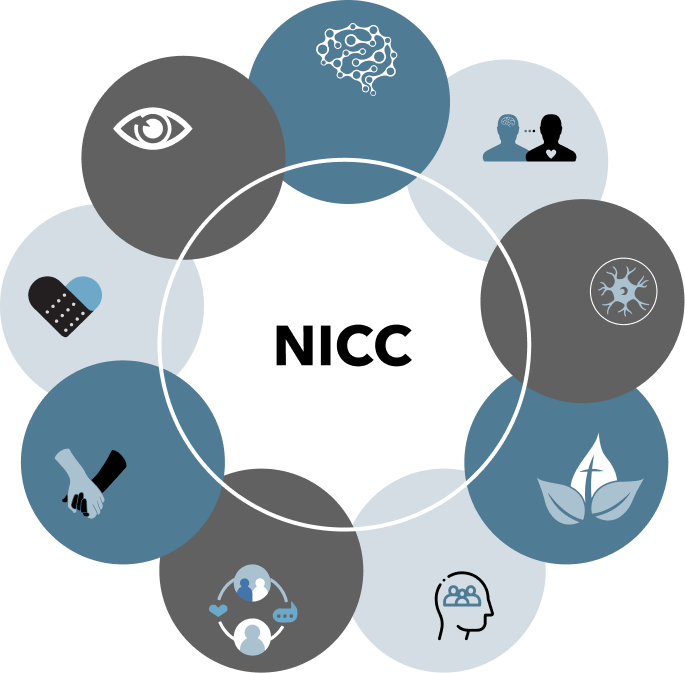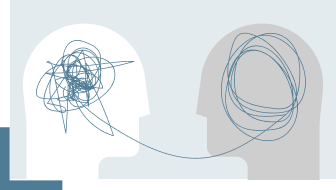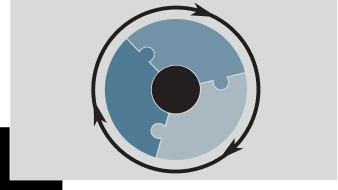God designed your brain to heal and your soul to thrive.
Neuroscience Informed Christian Counseling® (NICC) is the transformational approach developed at MyCounselor.Online that unites the best of modern clinical science with the timeless truth of Scripture.
Christ at the center of every session
Healing happens in connection, not isolation
Rooted in research, not just good intentions
93.6% report success
Sign Up For The NICC Newsletter
If you’ve explored approaches like AEDP, EFT, IFS, EMDR, or other attachment-based, emotion-focused, and experiential therapies, you’ll recognize familiar ground. But here’s what sets NICC apart: it’s unapologetically Christ-centered from the ground up.
Developed by Josh Spurlock, MA, LPC, CST, and the MyCounselor.Online clinical team over 20+ years, NICC integrates cutting-edge neuroscience, attachment theory, and trauma research with a biblical vision of the human soul. NICC is not here to just reduce symptoms. We help heal deep wounds, fill the gaps where nurture was missing, and transform coping strategies that once helped you survive but now keep you stuck. We call this maturing into your true self in Christ—secure, connected, emotionally healthy, and living out His love.
In a 2024 study of 1,211 clients, 93.6% reported a successful outcome after completing NICC care, which is virtually unheard of in the mental health field (where 70% is considered average and 80% is excellent).
This isn’t “Christian-flavored counseling.” It’s an evidence-backed, Spirit-led process that honors both God’s design for the brain and His plan for the heart.
Spurlock, J. (2024). “Effectiveness of NICC in Online Faith-Based Therapy: A One-Year Study”:
This is the kind of counseling that changes lives—because it changes the way we understand people, pain, and healing. Whether you’re looking for help or looking for a model to trust, NICC offers a proven, Christ-centered path to wholeness.
NICC reflects a deeply biblical vision of human flourishing. It draws from Scripture and centuries of Christian soul care to form a model rooted in truth.
Theologically NICC’s understanding draws from theologians such as Wayne Grudem, Stanley Horton, Dallas Willard, Gordon Fee, F.F. Bruce, Harold Hoehner, William Klien, Craig Blomberg, J. Scott Duvall, J. Daniel Hays, Thomas Schreiner, D.A. Carson, Darrell Bock, Douglas Moo, Craig Keener, N.T. Wright, and study resources including the BDAG lexicon, TDNT, TDOT, NIGTC, Dictionary of Paul and His Letters, and others of this tradition.
We also look to contemplative Christian practices of spiritual formation and direction influenced by Ignatius of Loyola and others.
Resources That Shape NICC:
The following list represents a brief bibliography of theological writings that influence Neuroscience Informed Christian Counseling® (NICC).
The list is not exhaustive and does not represent an embrace or endorsement of every perspective taken by the authors.
NICC is grounded in 100+ years of mental health research and 6,000+ years of theological reflection.
It integrates the best of modern trauma-informed, attachment-based, and experiential models:

Modern Clinical Models Integrated into NICC:
The leading developer for Accelerated Experiential Dynamic Psychotherapy (AEDP) is Diana Fosha. From AEDP we draw our focus on the phenomenology of affective experience, the primacy of affect in creating change, the operationalization of our therapeutic stance, understanding of anxiety, defense, and core affective experience, the mechanics of processing emotion to completion, meta-therapeutic processing, and a model of supervision based on direct observation of video, to name a few. In many ways NICC is a translation and expansion of AEDP and is primary in NICC’s application with individuals.
The leading developer for Emotion Focused Couples Therapy (EFT) is Susan Johnson. From EFT we draw our understanding of attachment driven interpersonal cycles of interaction, organization of therapeutic work into stages and steps, and restructuring bonds through restructured interpersonal enactments. EFT is primary source for NICC’s application with couples and families.
The leading developer for Attachment Focused Eye Movement Desensitization and Reprocessing (AF-EMDR) is Laurel Parnell. From AF-EMDR we draw structuring of therapeutic work, use of imagery in processing traumatic memory, targeting and following of memory networks, verifying completion of processing, understanding of Adaptive Information Processing (AIP), and resource development through imagery work.
The leading developer for Internal Family Systems (IFS) is Richard Schwartz. From IFS we draw our understanding of parts work and ego states.
The leading developer for Schema Therapy is Jeffery Young. From Schema Therapy we draw limited reparenting and early maladaptive schemas.
The leading developer for IPNB is Daniel Siegel. From IPNB we draw our understanding of nervous system anatomy and function, mental health as whole brain integration, theory of mind, self-reflective capacity, and intersubjectivity.
The leading developer in Polyvagal Theory is Stephen Porges. From Polyvagal theory we draw our understanding of vagal nervous system states and window of tolerance.
The leading developer in Right Brain Psychotherapy is Allan Schore. From Right Brain Psychotherapy we draw our understanding of limbic resonance, regulation, and revision.
The leading developer for Memory Reconsolidation is Bruce Ecker. From Memory Reconsolidation we draw our understanding of the therapeutic reconsolidation process, transformation sequence, and the role of mismatching experiences.
The leading developer in Trauma Informed Practice is Bessel van der Kolk. From Trauma Informed Practice we draw our understanding of trauma’s effect on the nervous system and trauma symptomology as protective features of the body.
Each of these models contributes key insights into how the brain heals—insights that NICC applies through a biblical lens.
The modern theories and models in neuroscience build and expand on the work of earlier theorist who lacked the scientific measuring tools to ground their findings in direct observation of the nervous system or to conduct widespread controlled studies. Still their keen observation and experiments in treatment have made meaningful contribution to our understanding. While NICC strongly disagrees with some of the conclusion these theorists drew from their observations, we find value in their observations when understood through the lens of the Bible.
NICC isn’t just a counseling model—it’s a full developmental framework and theory of change. It’s taught and supervised through our rigorous two-year postgraduate residency, equipping master’s and doctoral-level therapists to deliver biblically faithful, clinically sound care.
Because the models behind NICC are already recognized as evidence-based practices, professionals can confidently refer clients, knowing they’ll receive gold-standard care infused with gospel truth. Many also choose to train in NICC to deepen their own impact in ministry or practice.
NICC was created to help us help others. NICC provides a simple yet comprehensive framework for understanding people and their problems. Rooted in neuroscience and the timeless truths of the Bible, it gives a trustworthy map for navigating how to help. NICC takes the mystery out of transforming trauma into thriving by providing clear, simple, well-defined pathways and signposts for meaningful change.
NICC is largely a translational and integrative model. Building on and emerging from well-developed and researched models of therapy and Biblical soul care wisdom practiced for millennia. The result is a distinctly Christian clinical model articulated precisely for training, supervision, and research.
NICC isn’t just something we do—it’s a model we train others to use.
It’s an accelerated pathway to counseling, competence, and confidence, by giving you:

Simple, yet comprehensive framework for understanding people and their problems

Trustworthy map for navigating how to help - taking the mystery out of transforming trauma into thriving

Clear, simple and defined pathways and sign posts for change

System for accelerating the development of your counseling intuition and ‘trust your gut’ skills
NICC helps you help others—faster, deeper, and with confidence.
Sign Up For The NICC Newsletter
A Framework for Healing and Growth
NICC is a clinical, theological, and developmental model built to help people heal from trauma, repair developmental deficits, and grow into their God-given identity. It’s grounded in the belief that humans are embodied souls—integrated beings of body, mind, and spirit—designed for connection, growth, and joy.
Central to this framework is the concept of the Thrive-Drive—God’s life-giving impulse within us, calling us toward growth and wholeness. This divine spark pushes us to mature into our Soul DNA—the unique, God-breathed blueprint of who we were always meant to be. But life wounds us. Sin, trauma (wounds), neglect (gaps), and coping mechanisms (immature habits) shape a false self that keeps us stuck.
NICC helps us journey back to the true self—who God created us to be from the beginning.
Healing and growth in NICC happen across five key areas of development:
These domains guide both the therapeutic journey and spiritual growth.
NICC emphasizes that lasting change comes through life-giving experiences—moments of safety, attunement, and connection that contradict the pain of the past.
These experiences activate:
Neuroplasticity: the brain’s capacity to rewire itself
Memory reconsolidation: updating old mental/emotional patterns
NICC Helps You:
✓ Repair trauma wounds
✓ Fill developmental gaps
✓ Update internal maps of self and relationships
✓ Find true happiness: peace, joy, hope
This is what the Gospel looks like in therapy: not just forgiveness, but formation. God isn’t just interested in making you forgiven—He’s committed to making you whole.
Start your NICC journey today. Find a counselor who gets you—spiritually, emotionally, and neurologically.
Wondering if NICC is a model you can trust? Download the research study, explore the theology, and see how we support the people you shepherd.
Want to grow your impact with NICC? Train in a model that’s biblically faithful, clinically sound, and practically powerful.